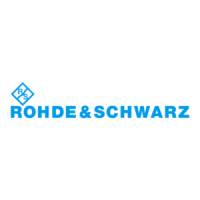Concepts and features
R&S
®
ZNA
130User Manual 1178.6462.02 ─ 20
The four 2-port Z-parameters can be interpreted as follows:
●
Z
11
is the input impedance, defined as the ratio of the voltage V
1
to the current I
1
,
measured at port 1 (forward measurement with open output, I
2
= 0).
●
Z
21
is the forward transfer impedance, defined as the ratio of the voltage V
2
to the
current I
1
(forward measurement with open output, I
2
= 0).
●
Z
12
is the reverse transfer impedance, defined as the ratio of the voltage V
1
to the
current I
2
(reverse measurement with open input, I
1
= 0).
●
Z
22
is the output impedance, defined as the ratio of the voltage V
2
to the current I
2
,
measured at port 2 (reverse measurement with open input, I
1
= 0).
Z-parameters can be easily extended to describe circuits with more than two ports or
several modes of propagation.
4.3.4 Admittance parameters
An admittance is the complex ratio between a current and a voltage. The analyzer pro-
vides two independent sets of admittance parameters:
●
Converted admittances (each admittance parameter is obtained from a single S-
parameter)
●
Y-parameters (complete description of the n-port DUT)
4.3.4.1 Converted admittances
The converted admittance parameters describe the input admittances of a DUT with
fully matched outputs. The converted admittances are the inverse of the Converted
impedances.
4.3.4.2 Y-parameters
The Y-parameters describe the admittances of a DUT with output ports terminated in a
short circuit (voltage = 0). The analyzer provides the full set of Y-parameters including
the transfer admittances (i.e. the complete n x n Y-matrix for an n port DUT).
This means that Y-parameters can be used as an alternative to S-parameters (or Z-
parameters) to characterize a linear n-port network completely.
2-port Y-parameters
In analogy to S-parameters, Y-parameters are expressed as Y
<out>< in>
, where <out>
and <in> denote the output and input port numbers of the DUT. In analogy to Z-param-
eters, the Y-parameters for a two-port are based on a circuit model that can be
expressed with two linear equations:
2221212
2121111
VYVYI
VYVYI
Meaning of Y-parameters
Measurement results

